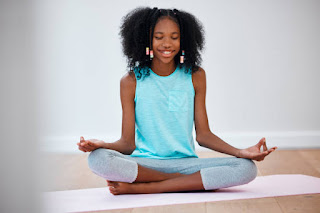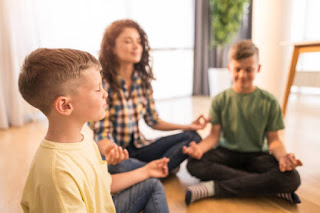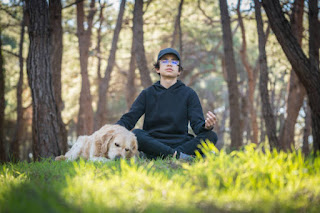Supporting Mental Health in Adolescents with Mindfulness and Yoga
Creating Resilience: Mindfulness and Yoga for Adolescent Mental Health
Adolescence is a period of significant emotional, social, and physical changes, making it a critical time for developing healthy coping mechanisms. Mental health challenges, including stress, anxiety, and depression, are increasingly common among teens. Yoga and mindfulness practices offer accessible, non-invasive ways to support mental well-being, helping adolescents build resilience, improve emotional regulation, and cultivate lifelong habits of self-care.
In this article, we’ll explore how yoga and mindfulness can benefit adolescent mental health, beginner-friendly practices that teens can try, and strategies for parents to support their children. Additionally, we’ll discuss ways for parents and teens to engage in shared activities that reinforce these coping strategies.
Why Adolescents Need Healthy Coping Mechanisms
According to the World Health Organization, half of all mental health conditions begin by age 14, highlighting the importance of early intervention. Adolescence is a formative period where habits—both beneficial and detrimental—are established. Developing positive coping mechanisms, such as yoga and mindfulness, can empower teens to manage stress, navigate emotional challenges, and improve overall mental health.
Research from the American Psychological Association suggests that mindfulness practices in young people can reduce symptoms of anxiety and depression, enhance emotional well-being, and improve focus. By fostering resilience and emotional regulation, yoga and mindfulness can help adolescents better handle stressors and build mental flexibility.
Yoga for Beginners: Simple Poses for Teens
Yoga offers both physical and mental benefits, making it a powerful tool for teens to manage stress and improve mood. Here are a few beginner-friendly poses that focus on grounding, relaxation, and gentle stretching:
- Child’s Pose (Balasana)
This pose helps calm the mind and release tension in the back and shoulders. It’s an excellent choice for teens needing a break to reset and center themselves. - Cat-Cow Stretch (Marjaryasana-Bitilasana)
A gentle flow between these two poses releases tension in the spine and helps synchronize breath with movement. This practice can improve focus and calm the nervous system. - Mountain Pose (Tadasana)
A foundational yoga pose, Mountain Pose encourages stability and groundedness. It’s a great way for teens to practice standing tall and feeling empowered. - Legs Up the Wall (Viparita Karani)
This relaxing inversion is perfect for relieving tired legs, calming the mind, and improving circulation. It’s especially beneficial before bed, helping teens unwind and prepare for restful sleep.
Encourage adolescents to take 5–10 minutes each day to practice these poses, especially when feeling overwhelmed or needing a moment to relax. Consistent practice can improve flexibility, reduce stress, and support a positive body image.
Mindfulness Meditation Practices for Adolescents
Mindfulness helps adolescents focus on the present moment, which can counteract the rumination often associated with anxiety and depression. Here are some simple, beginner-friendly mindfulness practices:
1. Breathing Exercise: Counting the Breath
Have teens sit comfortably and focus on their breath. Instruct them to inhale deeply, then slowly exhale, counting each breath up to ten and then starting over. This practice helps calm the mind, reduce stress, and improve focus.
2. Body Scan Meditation
In this meditation, teens gradually bring awareness to different parts of their body, starting from the toes and moving upward. It helps release tension and promotes relaxation, especially helpful before sleep.
3. Gratitude Journaling
Encourage teens to write down three things they are grateful for each day. This practice can shift focus from stressors to positive aspects of life, promoting a more optimistic outlook and reducing feelings of anxiety.
4. Mindful Observation
Encourage teens to spend a few minutes observing something in their environment—like a leaf, candle flame, or object in their room. This exercise enhances focus, encourages calmness, and helps them reconnect with the present moment.
By integrating these simple practices, teens can develop mindfulness habits that build resilience and provide tools for managing emotional stressors.
Strategies for Parents: Supporting Adolescent Mental Health Through Yoga and Mindfulness
Parents play a pivotal role in shaping their children’s attitudes toward stress management and self-care. Here are strategies for parents to encourage mindfulness and yoga practices, tailored to different age groups:
Ages 10–13: Encouraging Playful Exploration
At this age, children respond well to playful and imaginative practices. Introduce yoga as a fun activity by turning poses into animal shapes or creating stories around the movements. Consider using apps or videos designed for younger audiences to make mindfulness more engaging.
- Tip: Set aside a few minutes each evening for a family “yoga play” session. Show them simple poses like Tree Pose or Butterfly Pose, and encourage creative expression through movement.
Ages 14–16: Fostering Independence
Teens in this age group are seeking independence and may prefer practicing alone. Encourage mindfulness as a tool for stress relief and self-reflection. Offer support, but allow them space to explore their practice independently.
- Tip: Gift them a journal for reflection or a yoga mat to support their personal practice. Encourage them to try a short mindfulness or yoga session when they feel stressed, without pressuring them.
Ages 17–19: Developing Lifelong Habits
Older teens can benefit from understanding how mindfulness and yoga support long-term mental health. At this stage, introduce them to more structured practices, such as setting a specific time for daily meditation.
- Tip: Share articles or resources, such as the APA’s findings on mindfulness benefits, to help them appreciate the science behind these practices. Respect their autonomy while offering gentle reminders of the positive impacts these habits can have on stress management.
Shared Activities for Parents and Teens
Practicing mindfulness and yoga together can strengthen family bonds and create an atmosphere of mutual support. Here are activities that parents and teens can do together to foster shared coping mechanisms:
1. Family Meditation Time
Dedicate a few minutes each evening to meditate as a family. This practice not only benefits each individual but also creates a calm and supportive household environment.
2. Joint Journaling Sessions
Take time to journal together. Reflect on questions like:
- What’s one thing that made you smile today?
- What’s one challenge you’re facing, and how can you approach it mindfully?
Sharing insights (only if comfortable) can encourage open communication and help parents and teens understand each other’s stressors and coping strategies.
3. Nature Walks with Mindful Observation
Going for a walk and practicing mindful observation together can be a relaxing way to bond and appreciate the natural world. During the walk, encourage silence for a few minutes to fully engage with the surroundings. Afterward, discuss what you both observed.
4. Evening Yoga Routine
Set aside time once a week to practice yoga as a family. You could follow a simple online video or create a routine that everyone can participate in. This shared activity reinforces the importance of self-care and provides an opportunity to relax together.
Helping Parents Cultivate Their Own Coping Mechanisms
As parents introduce mindfulness and yoga to their children, it’s equally important to evaluate and strengthen their own coping mechanisms. Adolescents often model their emotional responses and stress management techniques after those of their caregivers, so establishing a personal self-care routine can benefit both the parent and child.
Self-Reflection Exercise for Parents
Encourage parents to reflect on their own coping strategies with questions such as:
- How do I typically respond to stress?
- What coping mechanisms do I use that I want my child to adopt?
- How can I improve my self-care to set a better example?
Building a Family Culture of Wellness
Parents who openly practice mindfulness or yoga set the tone for a healthy, supportive household. Consider adopting a “no technology” time, dedicated to mindfulness or quiet family activities. Creating space for calm and introspection within the home reinforces these values and shows teens the importance of setting boundaries for mental health.
Resources and Continued Learning
Encouraging teens and parents to explore reputable resources together can also deepen understanding and commitment. The National Alliance on Mental Illness (NAMI) and the Child Mind Institute provide extensive resources on adolescent mental health, mindfulness, and healthy coping strategies. Using these high-quality references can guide families in navigating mental health challenges more effectively.
Conclusion
Supporting adolescent mental health through mindfulness and yoga equips teens with valuable tools for managing stress, building resilience, and fostering emotional regulation. By integrating these practices into daily life, teens can develop a solid foundation for mental wellness that benefits them both now and in the future.
For parents, modeling these habits and participating in shared activities reinforces a family culture of well-being, helping everyone cultivate healthier coping mechanisms together. Building resilience in adolescence is a gift that can shape a lifetime of better mental health.









